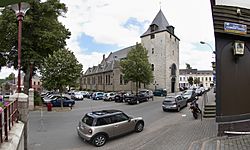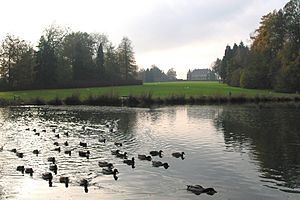La Hulpe facts for kids
Quick facts for kids
La Hulpe
|
|||
|---|---|---|---|
 |
|||
|
|||
| Country | Belgium | ||
| Community | French Community | ||
| Region | Wallonia | ||
| Province | Walloon Brabant | ||
| Arrondissement | Nivelles | ||
| Area | |||
| • Total | 15.60 km2 (6.02 sq mi) | ||
| Population
(2018-01-01)Lua error in Module:Wd at line 1575: attempt to index field 'wikibase' (a nil value).
|
|||
| • Total | Lua error in Module:Wd at line 1,575: attempt to index field 'wikibase' (a nil value). | ||
| Postal codes |
1310
|
||
| Area codes | 02 | ||
| Website | www.lahulpe.be | ||
La Hulpe (say "Lah Hoolp") is a town in Wallonia, a region in Belgium. It's located in the province of Walloon Brabant. The town is about 20 kilometers (12 miles) southeast of Brussels, the capital city of Belgium.
In 2007, about 7,300 people lived in La Hulpe. The total area of the town is about 15.6 square kilometers (6 square miles). A part of the famous Sonian Forest, which is a large forest, is also in La Hulpe.
La Hulpe has two smaller areas, like neighborhoods, called Gaillemarde and Malaise-Bakenbos. The borders of these areas changed a bit in 1963. This happened when the language border, which separates French-speaking and Dutch-speaking parts of Belgium, was officially set.
Did you know that the main office for the SWIFT organization is in La Hulpe? SWIFT is a big group that helps banks all over the world send messages to each other safely and quickly.
Contents
The Story of La Hulpe
Where Did the Name Come From?
The name La Hulpe comes from an old Celtic word, helpe. This word means "the silver river." The small streams that flow through La Hulpe form a series of ponds today. This area is now called L'Argentine, which also means "the silver."
Early Days and Town Rights
People lived in this area a very long time ago, even 10,000 years before Christ! We know this because an old axe made of smooth flintstone was found in Gaillemarde.
The village of La Hulpe was started by the Duke of Brabant. He cleared a hill that separated two valleys, Argentine and Mazerine. La Hulpe officially became a town on June 3, 1320. This happened when Duke Henri I signed a special paper called a charter.
La Hulpe became a mairie, which was like a local government center. It had the power to make important decisions and handle legal matters. It kept this status until 1792. There used to be a pillory (a wooden structure used for public punishment) near the church. It was taken down when the French ruled the area. Today, parts of it have been put back together and you can see them at the town hall.
From 1795 to 1814, La Hulpe was an important legal center. It had a court that handled cases for about ten nearby towns. After Belgium became independent, La Hulpe lost some of its official roles. It then became part of the Wavre area.
The Church of La Hulpe
The church in La Hulpe is very old. It was first mentioned in a document from 1226. You can see the church in one of the oldest pictures of La Hulpe. This picture is on a special tapestry (a woven picture) from Brussels. It's called the Hunts of Maximilian and is now in the Louvre Museum in Paris. The tapestry shows a hunting scene from the time of Emperor Charles V.
Most of the church has been changed over the years, except for the tower and the main part inside. The last big changes were made in 1906. Behind the church, there is a memorial for King Baudouin. It's near a special oak tree that was planted to celebrate Belgium's 100th birthday.
Paper Making in La Hulpe
For about 300 years, making paper was very important for La Hulpe's economy. It was a good place for paper mills because it was close to Brussels and had plenty of clean water. The first paper mill was built on the Grand Etang (Big Pond).
In 1664, King Philip II of Spain allowed a special paper factory to be built in La Hulpe. It was called the "Imperial and Royal Paper Manufacture." The paper-making industry in La Hulpe finally stopped in 1970.
The Solvay Domain and Castle
The castle of La Hulpe was built in 1842 in a French style. In 1893, a rich man named Count Ernest Solvay bought it. Later, in 1968, his grandson gave the castle to the Belgian government.
The castle is surrounded by a huge area of 227 hectares (about 560 acres). This area has fields, woods, and ponds. It's known as the Domaine Solvay. Today, the Walloon Region and an organization called the Domaine Solvay association manage the castle and its land.
The domain is very beautiful and important. It was protected by a special law in 1963 because of its beauty. It was also added to a list of important heritage sites in Wallonia in 1993. It's even part of a special nature protection area called Natura 2000. In 1988, a movie called Le Maître de musique (The Music Teacher) was filmed at the castle and in the park.
The Folon Foundation
The farm building of the castle was built in 1833. Today, it is home to the Folon Foundation. This foundation opened on October 27, 2000.
Jean-Michel Folon (1934–2005) was a very famous artist. He was known for his illustrations and posters in the second half of the 20th century. In the 1990s, Folon decided to create a foundation in the Solvay Domain. This was a special place for him because he used to play there when he was a young boy.
He gave the foundation more than 300 of his artworks. These works are displayed in 15 rooms of the old farm building. In its first year, the foundation welcomed 80,000 visitors!
Royal La Hulpe Sporting Club
La Hulpe is home to the Royal La Hulpe Sporting Club. This is a local sports club for the community.
Famous People from La Hulpe
- Dr. Patrick Hunout, who started The Social Capital Foundation, lived in La Hulpe for a long time.
- Baron Pierre de Caters (1875–1944) was the first Belgian aviator (someone who flies airplanes). He lived in an estate now called Domaine de Nysdam.
- Michael Klawans, a basketball player known for his three-point shots. He was nicknamed White Chocolate.
Image gallery
-
Château Solvay, built in 1842.
See also
 In Spanish: La Hulpe para niños
In Spanish: La Hulpe para niños








